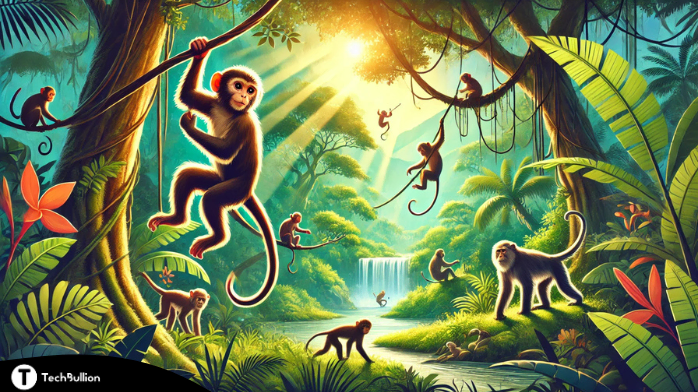
Monkeys are some of the most intriguing and intelligent creatures on Earth. With their playful personalities, incredible adaptability, and close genetic ties to humans, they have captured the imagination of researchers, animal lovers, and wildlife enthusiasts worldwide. In this article, we’ll explore the world of monkeys in depth, covering their habitats, behaviors, and their significant role in ecosystems. Whether you’re looking to learn more about monkeys or just curious about these fascinating animals, this guide will dive into everything you need to know.
What Are Monkeys?
Monkeys are primates, a group of mammals that also includes humans and apes. Known for their intelligence, They are divided into two primary groups:
- Old World Monkeys (found in Africa and Asia)
- New World Monkeys (found in Central and South America)
Old World monkeys, such as baboons and macaques, have narrow noses and often lack prehensile tails. In contrast, New World , like capuchins and howler, are known for their prehensile tails, which act as a fifth limb to help them navigate their arboreal homes.
Habitat and Distribution
Monkeys inhabit a wide variety of environments, from tropical rainforests to arid savannas. Some species, like the Japanese macaque, can even survive in snowy conditions. Their adaptability has enabled them to thrive across continents, making them one of the most widespread groups of primates.
Top Monkey Habitats Around the World:
- The Amazon Rainforest: Home to howler monkeys, spider monkeys, and tamarins.
- Africa’s Savannahs: Baboons and vervet monkeys are common here.
- Asian Forests: Langurs and macaques dominate these regions.
Monkey Behavior: Playful and Intelligent
One of the most striking features of monkeys is their playful and social behavior. Living in groups called troops, monkeys form complex social structures. These groups are often led by a dominant male, but some species, like bonobos, have matriarchal hierarchies.
Common Monkey Behaviors:
- Grooming: This is not just about hygiene but also about bonding and reinforcing social ties.
- Tool Use: Capuchins and some other species use tools like sticks to access food or crack nuts, showcasing their remarkable intelligence.
- Communication: Monkeys use a variety of vocalizations, facial expressions, and body postures to communicate with one another.
Diet: What Do Monkeys Eat?
Monkeys are omnivores, meaning they eat both plant and animal matter. Their diet primarily consists of:
- Fruits: A favorite for most monkey species.
- Leaves: Especially for larger species like colobus monkeys.
- Insects: An essential source of protein.
- Small animals or eggs: Occasionally consumed by some monkey species.
Their foraging habits play a vital role in maintaining ecological balance, as they help disperse seeds and contribute to forest regeneration.
Monkeys and Their Role in Ecosystems
Monkeys are keystone species in many ecosystems. By dispersing seeds, they ensure the growth of diverse plant species, which in turn supports other wildlife. Additionally, they serve as prey for larger predators, maintaining the natural food chain.
However, habitat destruction and climate change are threatening many monkey species, disrupting their roles in ecosystems.
Famous Monkey Species
1. Capuchin Monkeys: Known for their intelligence, capuchins are often used in research and entertainment.
2. Howler Monkeys: Famous for their loud calls, these New World monkeys are among the noisiest animals on Earth.
3. Japanese Macaques: Also called snow monkeys, they are known for bathing in hot springs during winter.
4. Mandrills: Recognized by their colorful faces, mandrills are the world’s largest monkeys.
5. Golden Lion Tamarins: With their striking golden fur, these tiny monkeys are a conservation success story.
Conservation Efforts
Due to deforestation, hunting, and the illegal pet trade, many monkey species are endangered. Organizations worldwide are working to protect their habitats and prevent their extinction.
Steps to Save Monkeys:
- Supporting eco-tourism to provide sustainable income for local communities.
- Enforcing laws against illegal wildlife trade.
- Restoring and protecting forest habitats.
- Raising awareness about the importance of monkeys in ecosystems.
Fun Facts About Monkeys
- Monkeys Have Opposable Thumbs: Like humans, monkeys use their thumbs to grasp objects.
- They Can Recognize Themselves in Mirrors: This is a sign of self-awareness, observed in species like rhesus macaques.
- Monkeys Are Great Problem-Solvers: Their intelligence allows them to adapt quickly to new challenges.
- Some Monkeys Have Prehensile Tails: This unique feature is mainly found in New World monkeys.
Monkeys in Culture and History
Throughout history, They have appeared in folklore, art, and religion. In Hindu mythology, the monkey god Hanuman is a symbol of strength and devotion. Similarly, in Chinese culture, the Monkey King is a beloved character in the classic novel Journey to the West.
Also feature prominently in modern media, from cartoons to movies, further highlighting their popularity and charm.
Why Monkeys Matter
Monkeys are more than just adorable and entertaining creatures. They play a critical role in maintaining biodiversity and offer valuable insights into human evolution and behavior. By protecting, we are also safeguarding the health of the planet.
How You Can Help
If you’re inspired to support monkeys, consider:
- Donating to wildlife conservation organizations.
- Avoiding products that contribute to deforestation.
- Educating others about the importance of preserving monkey habitats.
Conclusion
Monkeys are truly fascinating creatures that deserve our admiration and protection. Their playful antics, complex social lives, and crucial ecological roles make them one of nature’s most captivating animals. By understanding and supporting their conservation, we ensure a future where these incredible primates continue to thrive.
Whether you’re a wildlife enthusiast or just starting your journey into the world of animals, learning about is an enriching experience that connects us to the beauty and complexity of the natural world.




